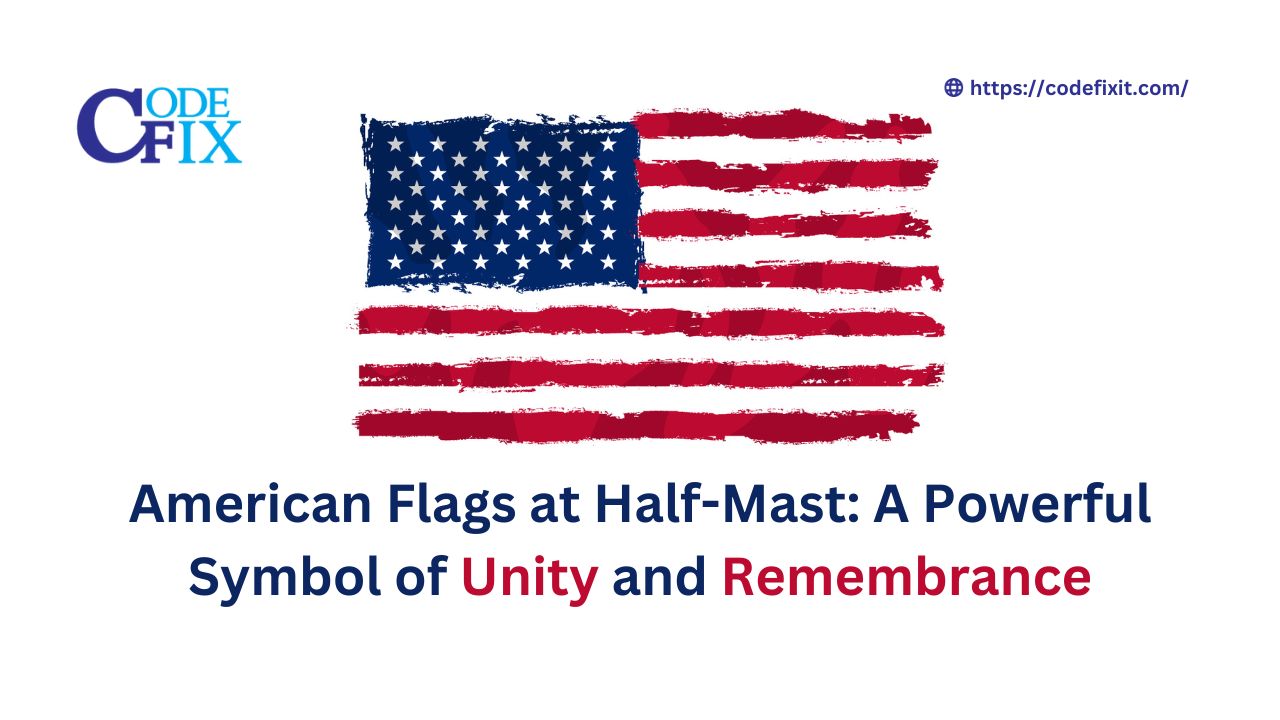The American flag, a symbol of unity, freedom, and national identity, is often seen as a source of pride and inspiration. However, there are moments when this emblem takes on a different role, one that speaks to the nation’s capacity for collective grief and reflection. These are the occasions when the flag is lowered to half-mast, a gesture laden with profound symbolism. It is a visual manifestation of mourning, a stark reminder of national tragedy and loss.
In this article, we embark on a journey through history to explore the solemn practice of flying the American flag at half-mast during times of national sorrow. We will delve into the specific events and instances that have led to this somber display and the impact it has on the collective psyche of a nation. From the aftermath of devastating terrorist attacks to the ravages of natural disasters and the passing of revered leaders, the half-masting of the flag tells a story of resilience, remembrance, and the enduring spirit of a people united in mourning.
Specific national tragedies and events that have led to the flag being flown at half-mast
Numerous national tragedies and significant events in U.S. history have prompted the practice of flying the American flag at half-mast, such as
September 11, 2001: The terrorist attacks on the World Trade Center and the Pentagon resulted in a nationwide display of the flag at half-mast. The act was a powerful symbol of mourning for the thousands of lives lost and a united response to the tragedy.
Pearl Harbor Attack (1941): Following the surprise attack on Pearl Harbor, President Franklin D. Roosevelt ordered the flag to be flown at half-mast to honor the servicemen who perished and to signify the country’s entry into World War II.
Assassination of President John F. Kennedy (1963): The nation was stunned by the assassination of President Kennedy. In his honor, the flag was lowered to half-mast, reflecting the profound loss felt by the American people.
Space Shuttle Challenger Disaster (1986): The explosion of the Space Shuttle Challenger resulted in the deaths of seven astronauts, including schoolteacher Christa McAuliffe. In their memory, the flag was flown at half-mast.
Hurricane Katrina (2005): The devastating impact of Hurricane Katrina, particularly in New Orleans, led to the flag being lowered to half-mast as a sign of sympathy and support for the affected communities.
Oklahoma City Bombing (1995): The bombing of the Alfred P. Murrah Federal Building in Oklahoma City resulted in the loss of 168 lives. The flag was lowered in tribute to the victims and the city’s resilience in the face of tragedy.
Columbine High School Shooting (1999): Following the school shooting in Columbine, Colorado, the flag was lowered to half-mast as the nation mourned the loss of innocent lives.
COVID-19 Pandemic: During the COVID-19 pandemic, President Donald Trump issued proclamations for the flag to be flown at half-mast to honor the lives lost to the virus and to recognize The tireless dedication of healthcare professionals and first responders.
Natural Disasters: The flag has been flown at half-mast in response to natural disasters such as hurricanes, wildfires, and tornadoes that have caused significant loss of life and property.
Passing of Prominent Figures: The flag is often lowered to half-mast upon the death of prominent national figures, such as former presidents, Supreme Court justices, and other leaders, as a mark of respect and mourning.
These specific events demonstrate the versatility of the American flag as a symbol of national unity and empathy during times of sorrow and challenge, as it conveys the shared grief and solidarity of the American people.
Some acts of violence
Acts of violence have sadly been responsible for several instances of the American flag being flown at half-mast. Here are some notable examples given below
Oklahoma City Bombing (1995): The tragic event involving the bombing of the Alfred P. Murrah Federal Building in Oklahoma City by domestic terrorists resulted in the deaths of 168 people. In the aftermath, the flag was flown at half-mast to honor the victims and condemn the act of violence.
Columbine High School Shooting (1999): The tragic shooting at Columbine High School in Colorado, where students Eric Harris and Dylan Klebold killed 15 people before taking their own lives, led to the flag being lowered in mourning for the victims and as a symbol of national grief.
Virginia Tech Shooting (2007): The deadly shooting rampage at Virginia Tech, where 32 people were killed by a lone gunman, prompted the flag to be lowered to half-mast to remember the victims and express solidarity with the university and the community.
Sandy Hook Elementary School Shooting (2012): The horrific shooting at Sandy Hook Elementary School in Newtown, Connecticut, claimed the lives of 20 children and six educators. The flag was flown at half-mast across the country in a show of mourning and support.
Orlando Pulse Nightclub Shooting (2016): The attack on the Pulse nightclub in Orlando, Florida, in which 49 people were killed and many others injured, led to the flag being lowered to half-mast as a sign of national sorrow and solidarity with the LGBTQ+ community.
Las Vegas Shooting (2017): The mass shooting at a music festival in Las Vegas, where 58 people were killed and hundreds injured, resulted in the flag being flown at half-mast to remember the victims and their families.
Tree of Life Synagogue Shooting (2018): The attack on the Tree of Life synagogue in Pittsburgh, Pennsylvania, in which 11 worshippers were killed by a gunman, prompted the flag to be lowered as a symbol of mourning and to denounce hate-driven violence.
These acts of violence shook the nation and elicited a unified response, with the flag at half-mast serving as a visual representation of the collective grief, sympathy, and condemnation of such tragic events.
In conclusion, Throughout history, specific acts of violence, from terrorist attacks to school shootings, have triggered the lowering of the flag, turning it into a symbol of solidarity, empathy, and resilience. Each time, the nation comes together to mourn the victims, support the survivors, and denounce the perpetrators of such violence.
As the flag is raised once more to full mast, it signifies not only the passage of time but also the nation’s determination to heal, learn, and prevent such tragedies from happening again. The American flag at half-mast serves as a powerful reminder that in the darkest of moments, the nation’s strength lies not only in its symbols but in the unity of its people, bound together by a shared sense of sorrow and a collective resolve to overcome adversity.






